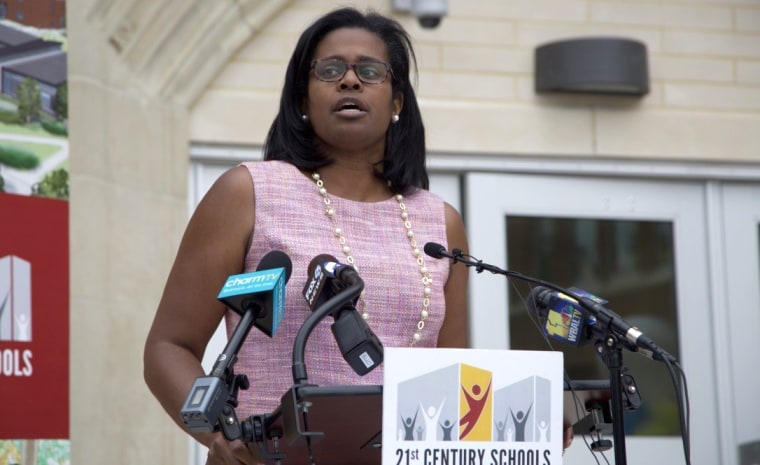The week before school started in early September, Dr. Sonja Santelises, CEO of Baltimore City Public Schools, was visiting campuses as they prepared for the new academic year. At the top of her ‘to-do’ list that week was ribbon-cuttings for two newly redesigned and renovated schools, Arlington Elementary and Reach! Partnership High.
“It feels good knowing kids are literally going from some of the worst buildings in the district to brand-new fabulous spaces,” Santelises said.
But overhauling old school buildings isn’t the only significant work going on in a school system that serves 82,000 students in 170 schools. In her fourth year at Baltimore City, Santelises continues to follow her “blueprint for success,” strategies designed to improve the school system and student growth. And she’s seeing some positive results.
“We have momentum, and the momentum is a trajectory up. And that’s what you want,” Santelises said. “We still have a long way to go.”
The Maryland State Department of Education recently released the results of their standardized academic performance tests, called Partnership for Assessment of Readiness for College and Careers, or PARCC. Although the Baltimore City school system is ranked 24th in the state, it saw improvements for the second year in a row. Last year, 90 schools improved their English Language Acquisition test scores, and this year 110 schools showed improvement.
“Even if not all are improving at 5 percent or above, the fact that we had a larger share of schools that were improving is just heartening,” Santelises said. “We’re moving in the right direction, and it’s verification that the focus and hard work are paying off.”
Santelises took over as chief executive in 2016, bringing 25 years of experience in urban school systems, including service as Baltimore’s chief academic officer from 2010 to 2013. Several challenges were waiting for her, like a $130 million budget gap and outdated and run-down school buildings. The schools faced declining enrollment and low test scores and graduation rates.
“When Sonja became the leader of Baltimore City Schools, they had enormous fiscal and operational challenges, which are a big deal,” said Mike Magee, CEO of Chiefs for Change, an organization of school superintendents and chiefs of state education departments supporting innovative educational strategies. Santelises became a member of the group in 2016, shortly after she took the helm in Baltimore.
“If facilities are not adequate, if transportation doesn’t go well, if food service doesn’t go well, families feel that first,” Magee said. “Sonja certainly set to work in addressing all of the big challenges that the city and the district were facing.”
Santelises came in with a plan to work with the community to decide priorities for the school system, developing a “blueprint for success” that would focus on three key areas: literacy, staff leadership and student wholeness – which means looking at students as whole people, attending to social and emotional needs so students can fully engage in their education. That also includes making sure all schools have extra-curricular activities that don’t vary by neighborhood or zip code.
“We took our cue from the community,” she explained. “Yes, we want test scores to rise; yes, we want our kids to get what they need. But the reality is, they’re whole people and whole people don’t just do one thing.”
Investment in curriculum is also a critical part of the plan for Baltimore City.
“If we don’t provide teachers with that strong foundational rigorous content-rich curriculum,” Santelises said, “then we are making their jobs 10, 20, a hundred times harder than it needs to be.”
Santelises committed to selecting curriculum that was rigorous, but also included content relevant to Baltimore students, grounded in the history and art of their community.
“She engaged teachers in the decision-making around curriculum adoption in a way that was as highly effective as I’ve ever seen,” Magee said, “and she spent the time talking to teachers and to the community to really understand the concerns they would have about any big changes to content and instruction in Baltimore City Schools.”
They’ve also expanded the gifted and talented program, and this year, for the first time, every high school will offer advanced placement classes. The investment is paying off in student engagement.
“What we’re finding is that the kids are rising to the task,” Santelises said, “even kids with significant gaps in skills.”
She’s quick to point out that there’s a long road ahead, but she thinks Baltimore’s public schools are on the right path. They’re seeing successes even as they struggle to improve. Some schools are seeing increased enrollment, and there’s improvement in retaining highly respected teachers.
“We have elements in place that we believe are the right ones, and the data is bearing out, the movement is bearing out that they’re the right ones,” she said. “But we still have a long way to go.”
This article appears as part of coverage for “NBC News Learn Presents: Education Now Houston,” a two-hour live community event supported by the Chan Zuckerberg Initiative. For more information, go to nbcnews.com/learnhouston.
